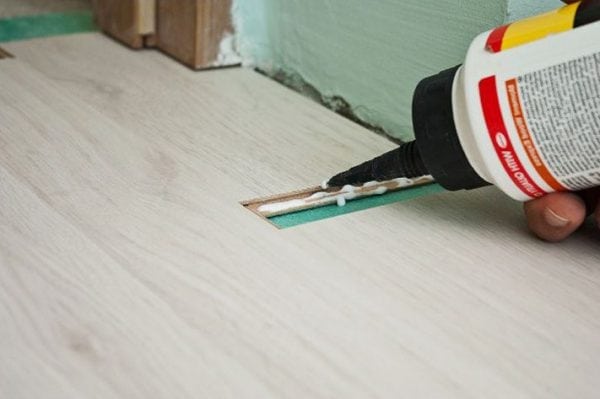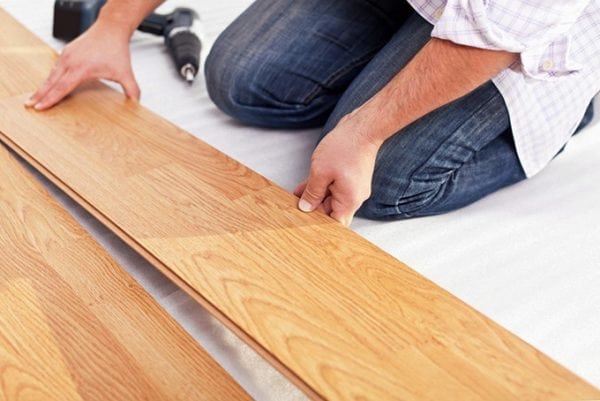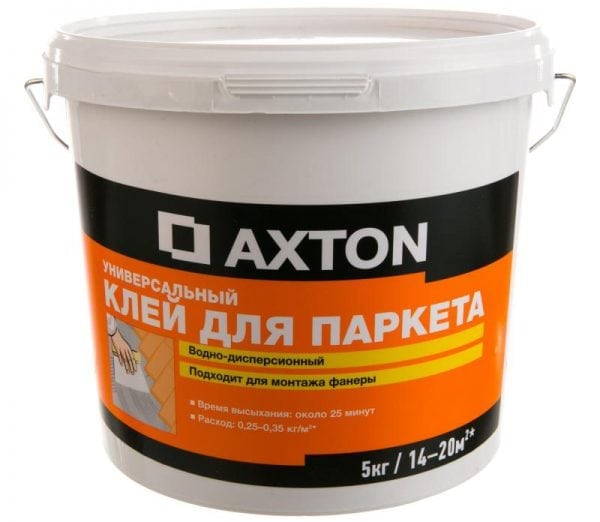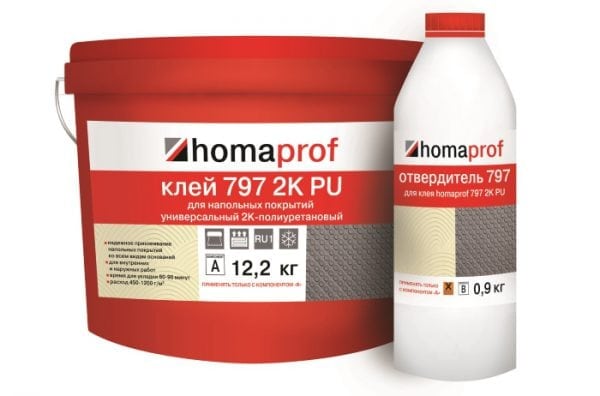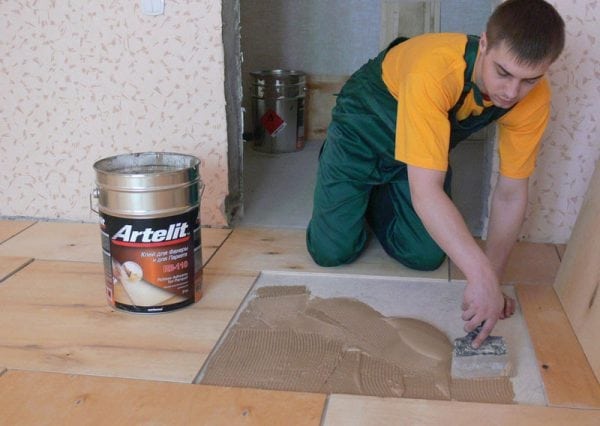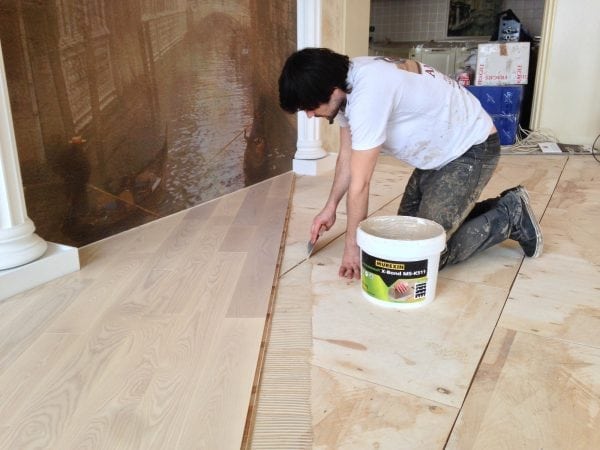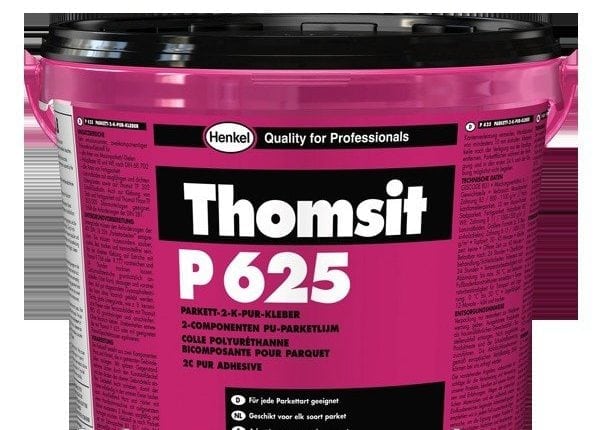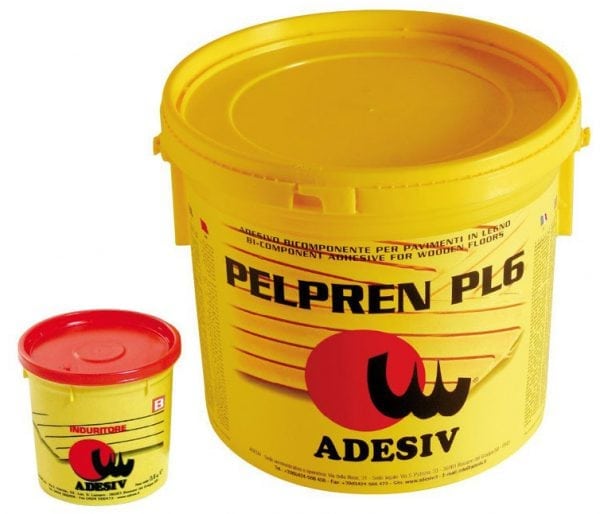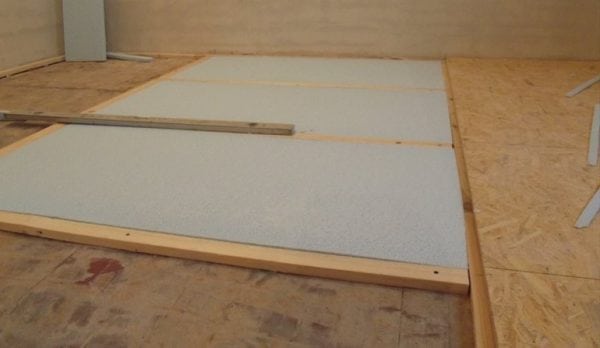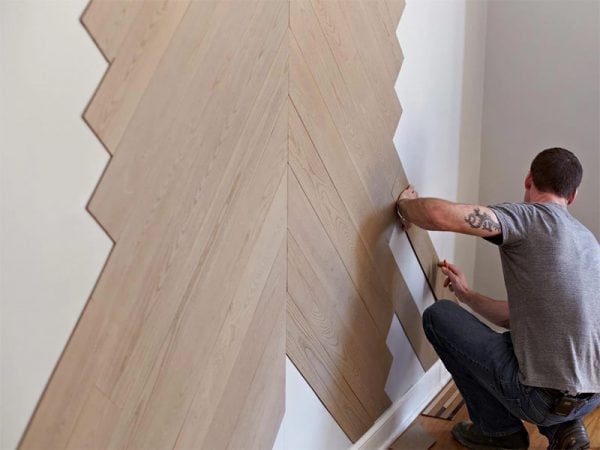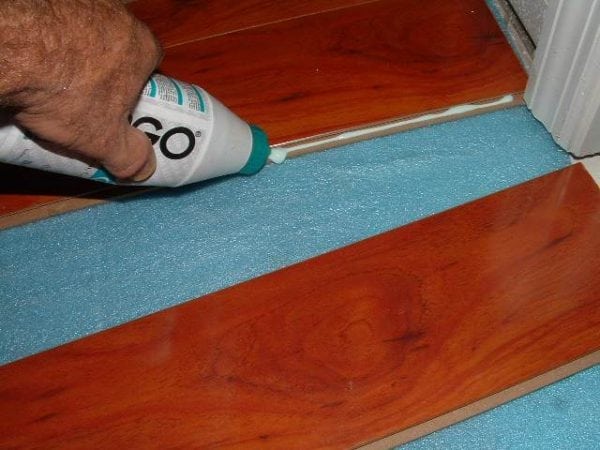Laying a laminate is possible in many ways. Some craftsmen connect parts with each other using the castle method. Other specialists prefer to use a different method - gluing the material. Indeed, the laminate board attaches well to the floor with adhesive. It is important to choose the right adhesive for the laminate, to know the technology of its application.
- The need for gluing laminate
- Advantages and disadvantages of technology
- Types of adhesive for laminate
- Water dispersion adhesives
- Synthetic Resin Adhesive
- Two-component polyurethane adhesive
- One-component polymer-based adhesive
- Adhesive Tips
- Laminate base
- Purpose of the room
- Conditions of use
- Resistance to temperature fluctuations
- Solidification time
- Popular brands of glue
- Leveling the floor before laying
- Gluing laminate flooring
- Procedure for repairing a laminate with glue
- Methods for removing glue from the laminate
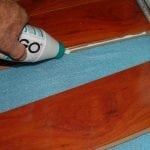
The need for gluing laminate
Laminated panels are a popular floor covering, including several pressed layers of fiberboard, MDF, polyvinyl chloride. The surface of the board (lamella) is a special film whose purpose is to protect the material from abrasion, moisture, damage. The inner layer includes a special base of impregnated kraft paper that will come in contact with the substrate. The side faces are covered with protective wax, at the ends there are locks for the joints of the boards.
The class of material is selected depending on the conditions of its operation, installation on the floor is carried out by simply joining the strips or by locking the connection. Previously, a special laminate without locks was produced, which could only be glued. Now any material has locks, regardless of the method of fastening.
So is it possible to stick this material? This is a very necessary stage of work; gluing will seriously increase the quality of laying, its strength, and durability. If you can get a laminate with a design without locks, you will have to glue it during installation in any case.
to contents ↑Advantages and disadvantages of technology
The creation of the so-called "glue castle" has its pros and cons. Putting the board on glue means providing better protection against moisture. Glue will act as a sealant. Dirt will accumulate less in the grooves, the aesthetic appeal of the floor will also be higher. Here are the other advantages of the method:
- increase in operational term of a covering;
- good adhesion, elimination of strip movement, strength of the entire structure;
- the ability to put boards anywhere without taking into account corners, curves.
By the way, the adhesive for the laminate is suitable for working with any surface. This means that you can lay a board with it not only on wood (on plywood or other substrates), but also on a concrete floor, brick, plastic, etc.
The disadvantages of using adhesive-based styling are also there. For repairs, you will have to disassemble most of the flooring, and the process will be difficult. Reuse of material is excluded. Also, after gluing parts with adhesive means, you can not immediately begin to use the floor - walk, put furniture.It is necessary to completely exclude the force impact on the floor where the installation was done, for 12 hours or more (depending on the type of glue).
to contents ↑For underfloor heating, this technique is extremely rare. Also, the use of adhesive technology will require additional costs for glue, and not everyone can carry out such complex work.
Types of adhesive for laminate
What is the best glue to choose if you decide to apply this method of styling? There are different mixtures that vary in composition. You should purchase the product in a specialized store where you can consult, buy only high-quality material.
Water dispersion adhesives
The composition of such products contains plasticizers, pigments, water, various additives based on vinyl, polyvinyl acetate, etc. Experienced craftsmen rarely acquire such adhesives. They are water-based and cannot adequately protect the coating from moisture. In addition, the adhesives themselves can cause deformation, swelling of the laminate.
to contents ↑Synthetic Resin Adhesive
Such adhesives are often referred to as liquid nails. In the composition they contain synthetic binders (resins). Application guarantees strength, durability, long-term use of the coating, reliable protection against moisture. But such adhesives can be quite expensive, and they are not used for boards with a thickness of less than 1.4 cm. Masters recommend using glue only for joints, carefully lubricating them.
to contents ↑Two-component polyurethane adhesive
What glue is best used when laying lamellas? It is believed that a polyurethane two-component adhesive with increased moisture resistance is ideal for a laminate. It includes cross-linked polyvinyl acetate and the laying strength will be very high. Glues are produced in two packages - the main composition and hardener.
to contents ↑One-component polymer-based adhesive
In the people such means are often called "superglue." As part of the adhesives there are no solvents, water, they are great for PVC laminate. Superglue hardens very quickly, so the installation should immediately be done correctly. Also, this type of composition requires a dry, reliable base for laying the board.
Adhesive Tips
How to glue a laminate and how to choose the right material? It is important to consider the basic criteria by which all such formulations are produced. They must be resistant to moisture, otherwise gluing will not make sense. Also, the adhesive must provide excellent adhesion to the substrate. Below are other rules for choosing a tool.
to contents ↑Laminate base
You can glue the laminate board to concrete (screed), to plywood, OSB. Depending on the type of substrate chosen, an adhesive composition should be sought. It should be suitable for the base material, providing a sufficiently strong grip.
Purpose of the room
The load on the floor must be taken into account when choosing glue. If the laminate is installed at home, the loads are moderate, but special hardness and adhesive strength are important in shopping centers, shops, office rooms.
Conditions of use
In addition to the load, it is necessary to provide for the frequency of contact with water. Sealing joints and the ability to withstand certain operating conditions are also written in the instructions for the adhesive. You should not neglect these characteristics.
Resistance to temperature fluctuations
Typically, a laminate is used only inside heated rooms; at sub-zero temperatures it is not used. Therefore, temperature fluctuations are taken into account mainly when installing underfloor heating. But the use of the adhesive method for warm floors is seriously limited and almost not practiced, only a professional can perform such a task.
Solidification time
The shorter the pour time, the more difficult the work of the installer. If a dry film forms on the surface of the composition, adhesion to the surface is impaired. A longer time between application and polymerization will be more convenient for the master, as well as ensure high quality and good adhesion.Therefore, it is not worth striving for a minimum drying time; it is better to wait a sufficient period before the coating starts operation.
to contents ↑Popular brands of glue
There are several manufacturers who produce really high-quality products. The most affordable are three brands of adhesives:
- "Tomsit." The leader in this segment of goods for the construction market. Glues "Tomzit" are not affected by moisture, they are not affected by temperature and household chemicals. Even with a very long service life, adhesives do not lose adhesion. The cost of funds is moderate, the price of work will be very favorable. Using glue, you can fix a vinyl adhesive laminate and other materials, including wooden coatings.
- "Cleo Laminate." Made in France, it is a quality tool for any laminate coating. The elasticity and strength of the connection are highest, while removing the glue from the laminate with its excess will not be difficult - there will be no spots.
- Kisel. This is a German brand that combines conventional and floating coatings. Brand adhesives are environmentally friendly, lack of toxic substances, and safe for humans. The cost is more than the price of the Russian counterpart, but the quality is appreciated by professionals above.
There are less popular products on sale:
- BASF FAST 3000. It is a synthetic two-component product with a minimum amount of fumes. It features fast drying - 2 hours.
- SIPOL. Italian glue with very high grip. It is suitable for gluing a laminate to any base, including a concrete screed without a substrate. Also sold as a two component formulation.
- ADESIV PELPREN PL6. Another two-component product, characterized by the absence of water, solvents, safety. Easy, strips removed from the surface of the laminate.
- FORBO 157 MS. Consists of a one-component mixture, made in Switzerland. It dries in 2 days, is expensive, but can be used even on underfloor heating, while it does not emit harmful substances (does not contain solvents).
Leveling the floor before laying
For a laminate floor leveling is urgently necessary, without this stage of work, the consequences can be sad. Inexperienced masters may not pay due attention to alignment, as a result of which they will receive the following:
- when laying on a curved surface, the load on individual elements will be higher, the floor will become unusable faster;
- castle joints are quickly loosened, literally in a couple of months they can begin to be damaged;
- uneven gaps appear between the boards, giving the floor an unaesthetic appearance.
The base should be as level as possible, while the materials used for this purpose must have high strength. Most often, alignment is carried out using glue for tiles, OSB and plywood, resulting in the so-called “dry screed”. Here are the features of the work:
- Plywood. Laying this material is advisable if the height differences are noticeable, but there is no increased humidity in the room. Large deforming elements are removed, they cover the floor with an antiseptic composition. Sheathed with plywood a wooden crate, mounted it on the floor, fixed with screws.
- Glue. The laminate can also be attached to tile glue, making it a kind of screed. But this option is suitable only in the presence of small surface defects. The height differences in this case are no more than 3 mm. The glue is combined with sawdust or small chips, preparing putty. Such a mixture is poured into the floor, smoothed it, simultaneously closing up small cracks.
- OSB. With this wear-resistant material, you can easily make a dry screed, the price will be low. Installation is similar to that for plywood sheets.
Gluing laminate flooring
Laminate boards are connected using the “shunt-groove” method - combining protrusions and recesses. The work is carried out in the following sequence:
- It is necessary to start work from the wall, leaving a gap of 1 cm. For this purpose, use pegs. Put the first panel end to the wall.
- Grease the recess of the second board with glue, glue with the previous one by pressing. To do this, use a wooden block, knocking a board to them and pressing it.
- Clean the laminate from excess glue until the product has dried. First with a dry cloth, then wet.
- Cut the last lamel of the desired length, also leaving 1 cm from the wall.
- The following rows are formed in a checkerboard pattern, for which the first board is cut in half in length. After three rows made, the work is evaluated, then it is continued after the glue has dried.
to contents ↑If the laminate will stick to the wall, then work is done from top to bottom from the ceiling. A clearance of 1 cm is also required. You need to glue the whole board with glue, and then force it against the wall. To seal the joints, the ends are also lubricated with glue.
Procedure for repairing a laminate with glue
Sometimes it is necessary to replace individual lamellas of the finished floor - in case of damage, displacement. The latter occurs most often when using the "floating floor". If there are cracks, they usually knock out, but this will not give a lasting result. Usually re-laying the laminate. There is also a simpler method for solving the problem - using glue. It is necessary to purchase high-quality laminate glue or liquid nails and do the following:
- maximize the gap by sliding the board;
- remove accumulated dust, dirt with a spatula;
- with a thin brush, grease the ends of two lamellas;
- move lamellas, remove excess glue with a cloth;
- Do not step on this floor during the day.
to contents ↑
Methods for removing glue from the laminate
Contact with the adhesive on the front surface of the laminate is found regularly even with careful work. Glue must be removed quickly so that it does not have time to dry. To do this, wipe the glue with a dry sponge or rags, then wipe the stain again with a wet cloth.
When the glue is already dry, you will have to buy special solutions to remove it. They are implemented as a spray and are well suited for laminate care. The product is sprayed, left for a couple of minutes, then glue is removed with a sponge. He can also clean the laminate from other stubborn stains. But it is better to remove the remnants of the adhesive immediately, so as not to create problems and unnecessary costs, while immediately receiving a beautiful new coating.

